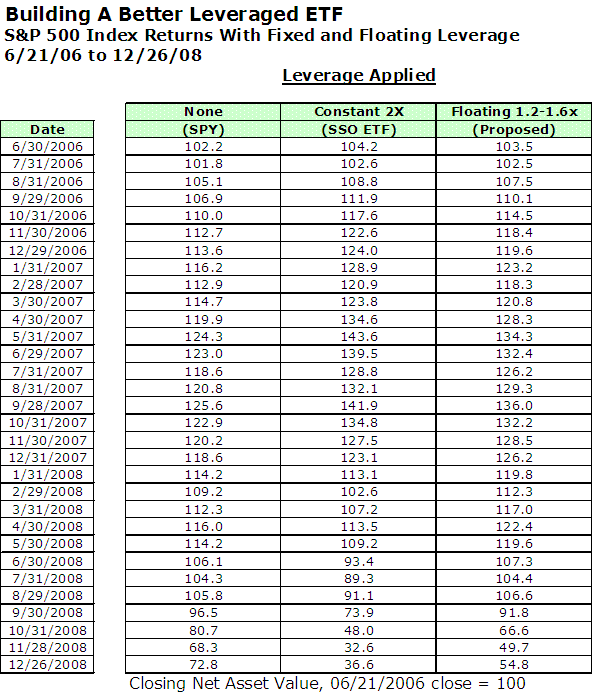What Can We Learn From the 2008 Leveraged ETF Collapse? Part 2
In part 1 of What Can We Learn from the 2008 Leveraged ETF Collapse, we compared estimated and actual returns of the ^SSO^ and uncovered a significant and unexpected 7.1% expense, and then showed that even without this drag that doubled returns can put a portfolio in a position in which it is virtually guaranteed to lag the underlying index.
But my grandfather taught me never to criticize something without offering a solution, so in this section we will focus on how to build an investment with more reward and less risk simply by managing the exposure and leverage ratio a little more effectively.
A leveraged ETF is designed to provide $2 of S&P 500 index exposure for every $1 of assets in the fund (before expenses, as we discussed previously). When the underlying index rises and the ETF profits, it increases its market exposure, and when the index falls and the ETF has losses, market exposure shrinks accordingly.
As a result, the leveraged ETF will almost certainly emerge from of a bull market with very high market exposure and then come out of a bear market with very low market exposure. For example, in October 2007, the ETF traded at $96 and each share had $192 worth of S&P 500 exposure, but by November 2007, the ETF was trading at $19 and had only $38 worth of index exposure.
Naturally, reducing index exposure is a reasonable way to reduce risk and avoid situations in which the last dollar could get wiped out. But it also severely limits the future profit potential, and it becomes very hard to develop scenarios in which the leveraged ETF could ever reach a previous high with an 80% smaller asset base.
The mechanics of changing the leveraged ETF’s index exposure on a daily basis are called “rebalancing”, but ironically the process is the exact opposite of a conventional rebalancing strategy used by a portfolio manager to reduce risk. Let’s consider a portfolio manager that keeps half their assets in an index fund and the other half in cash.
When the index fund rises, the position is trimmed and more funds moved into cash. Then when the index falls, the reverse happens, and funds are returned to the market. By rebalancing, the portfolio manager is more likely to enter a bull market with greater risk exposure and exit with reduced exposure. Over time, portfolio risk is reduced.
A fund manager can get a similar response from a leveraged investment by moving the leverage ratio in the opposite direction of the market. As the index rises the leverage ratio can be reduced in order to reduce market exposure, and when the index falls, the leverage can be increased to better capture the next upturn. Sell high and buy low.
In Figure below, we used the daily performance of the S&P 500 for the past two and a half years and built a portfolio in which the initial leverage ratio was set at 1.6x and then floated between 1.2x and 1.6x in order to maintain as consistent level of investment as possible. The S&P 500 and the leveraged ETF are also shown for comparison.

As expected, the portfolio leverage ratio falls to 1.26x as the S&P works its way through the bull market and then rises to 1.6x in the ensuing downturn, and by the end of 2008 the portfolio has 50% more assets than the 2x leveraged ETF and is much better positioned for a recovery, even with a somewhat lower leverage ratio.
How do we set the upper and lower leverage limits for a portfolio? One way is to work backward from the worst possible loss you would want to take and divide that by the worst possible loss a bear market is capable of. The answer will be different for every investor, but my guess is that it’s significantly less than 2.0, probably closer to 1.5.
Thus the final lesson from both the leveraged ETF and the year 2008 is to consciously manage your portfolio’s market exposure instead of letting it manage you.
While you’re waiting for the financial services industry to create this product, you can build it yourself using index futures and/or options or even with index ETF shares held on broker margin. Any of these assets can be used to create a low cost leveraged index investment, but then it’s up to you to adjust the exposure.
Tristan Yates is the author of Enhanced Indexing Strategies: Utilizing Futures and Options to Achieve Higher Performance and writes articles on index investing, options strategies, and leveraged portfolio management for Investopedia and Futures & Options Trader. He also helped lead the $1T Fannie Mae securities restatement. Yates has an MBA from INSEAD, a leading international business school.
